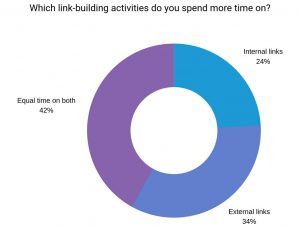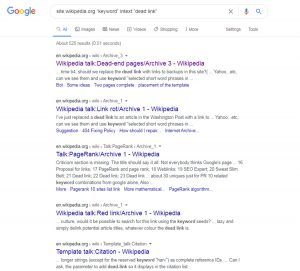Gone are the days when you could buy links or exchange links with anyone. Modern search engines like Google want to see natural link building efforts that add value for users.
The key is to focus on high-quality websites in your industry or niche. Earn links by providing useful content and resources that site owners actually want to share with their audiences.

When done right, link building delivers tremendous SEO benefits including:
- Increased search engine rankings and visibility
- More referral traffic to your site
- Greater brand awareness and authority
- Higher conversion rates
According to 51% of marketers, it only took three to four months to observe the impact of link building.

But what are the best tactics to get more (or better) backlinks? According to the guide to backlinking strategy, it will depend on what type of page you want to link.
Keep reading to discover 11 easy link building strategies any business can implement to gain more high-quality backlinks.
11 Easy Link Building Strategies for Business Success
1. Guest Blogging
Guest posting on popular industry blogs is a proven link building tactic. Reach out to site owners in your field and pitch relevant article ideas their audience would appreciate.
Be sure to craft posts that are informative, well-researched, and professionally written. Include useful graphics and stats as supporting details.
Most blog owners will include a bio section with your guest author bio. This presents a perfect opportunity to link back to your website. Over time, earning guest posts on authority sites will significantly boost your domain’s strength.
2. Link Reclamation
Reclaiming lost links is an easy way to build new links from existing online mentions. Start by searching your brand name on Google. Look for instances where your name is mentioned but not hyperlinked.
Contact the website owners and politely ask them to link to your site when mentioning your brand. Most will happily update old posts and turn those brand mentions into live backlinks.
Pro tip: Search for common misspellings of your brand too. Reclaiming variant mentions can help improve your brand name SERP dominance.
3. Resource Linking
Developing and promoting useful resources are fantastic for link building. Create tools, calculators, quizzes, and other assets website owners will want to share with their audiences.
For example, a catering business could create a printable party planning checklist. A car dealership might produce a custom loan calculator. Get creative with resources that provide value and align with your brand.
Publish your resources on your site or a dedicated landing page. Then actively promote them through outreach emails, social shares, and guest posts that embed or link back to the resource.
4. Sponsor Content
Paid sponsorships allow you to work directly with authoritative sites to earn high-quality links. For example, you might sponsor individual posts, videos, or even entire sections of a popular website.
Most sponsorships clearly disclose the paid relationship through text like “Sponsored by [Your Brand].” When done tastefully, these paid placements can significantly strengthen your backlink profile and referral traffic.
5. Industry Directories
Feature your business in industry-specific directories and lists like Best of [Industry] or Top 100 [Industry] Blogs. Site owners are often receptive to quality submissions as they help make their annual rankings more robust.
Make sure you meet all the criteria before applying. Then submit your best content, metrics, customer reviews, and other details that qualify your brand as a top player. Earning a spot earns a backlink and brand exposure to engaged audiences.
6. Conduct Interviews
Interviews continue to trend as popular content formats. Identify industry experts and thought leaders receptive to being interviewed. Offer to write up their insights to publish on your blog alongside an interviewee bio.
Most will appreciate the exposure and happily share a link with their audiences. To increase visibility, you might also pitch the interview to other relevant blogs for possible republication.
7. Give Testimonials
When you have a positive experience working with another company, offer to provide a testimonial for their website. Most brands have testimonial sections they’re looking to populate with social proof.
Write a thoughtful testimonial detailing how the business helped solve your problem or meet your needs. Ask them to include your name as a link back to your website. This enables you to earn a high authority backlink in a relevant context.
8. Claim Schema Markup
Markup your webpages with Schema.org structured data to generate rich snippets in Google search. Then claim your Schema through Google Search Console to further optimize how your brand appears in results.
Claiming your Schema not only helps your snippets rank better. It also allows Google to validate your website as the official authority on your brand entities. This translates into direct backlinks from Google’s Knowledge Graph.
9. Leverage Social Shares
Promoting your content across social media platforms like Facebook, Twitter, and LinkedIn can lead to new backlinks. How? Many people directly share links from social posts on their own profiles.
For example, a Twitter user might copy your tweet link directly into their own tweet or LinkedIn post. Each instance where a follower reshares your social content counts as a backlink.
So be sure to monitor brand mentions and check the source html to identify new social links from shares. Track these with your SEO tools just like other backlinks.
10. Outreach for Republishing
Find websites that already mention your brand and content. Then reach out to ask if they would be open to republishing one or more of your articles in full.
Most publishers are looking for quality content to share with their audiences. By offering them pre-written posts with graphics, stats, and engaging information, you make their jobs easier. In return, you can request they link back to your site.
The key is personalizing your pitch and simplifying the process for them. Send them the article copy and assets ready to integrate into their content system.
11. Find and Replace Broken Links
The web is full of broken links, which is effective on the SEO of the sites they are on. Finding and fixing these links can be a great link-building strategy. You can find a broken link on a website through tools, software or simply Google.
Write “Keyword” “Dead link” on search bar;

Contact the website and request them to fix their broken link. At the same time, you can also propose one of your articles to replace it.
In addition to finding and attempting to replace broken links, you can also find old or outdated links and attempt to replace them. Not only this will get you a link in an established piece of content, but it can also provide a better experience to readers now that there is a fresh and updated link in place.
Conclusion
Link building remains vital for SEO success. But gone are the days of spammy tactics. Today’s leading search engines reward natural links earned through quality content and outreach.
The great news? You don’t need a huge budget or team to implement effective link building. With a little time invested each week, any business can leverage these easy link building strategies to earn more high-quality backlinks.
What link building tactics have you found most effective? Share your top tips and results in the comments below!
Frequently Asked Questions
What are the most important factors for link building?
Relevancy, authority, and quality content. Focus on earning links from reputable sites closely related to your niche. Create resources that actually add value for publishers and readers.
How much time should I devote to link building?
Aim for at least 2-3 hours per week. Outreach and promotion take time. But consistency compounds results. Allow 6-12 months to build a robust profile of quality backlinks.
What if my outreach emails are ignored?
Response rates will vary. Follow up politely a few weeks later. Look for other contacts at the company. And don’t take it personally – even the best pitches get rejected or missed. Persistence pays off.
Should I disavow poor quality links?
Yes, it’s smart to distance your site from toxic backlinks using Google’s disavow tool. But focus more energy on building new high-quality links to outpace negatives.
What are Google’s guidelines around paid links?
Google allows paid links disclosed through nofollow/sponsored tags. But tread carefully, as excessive paid links or link networks may trigger penalties. For safest SEO, earn natural links.
How do I monitor new backlinks to my site?
Use link tracking software to identify new links from placements and outreach. Review your link profile regularly for low-quality links that should be disavowed.
What’s a realistic timeline to see results from link building?
Begin tracking your domain and page authority metrics. It often takes 6-12 months of consistent link building to move the needle on rankings and organic traffic. But the long-term rewards are well worth the investment.
Disclosure: The articles, guides and reviews on BlowSEO covering topics like SEO, digital marketing, technology, business, finance, streaming sites, travel and more are created by experienced professionals, marketers, developers and finance experts. Our goal is to provide helpful, in-depth, and well-researched content to our readers. You can learn more about our writers and the process we follow to create quality content by visiting our About Us and Content Creation Methodology pages.
